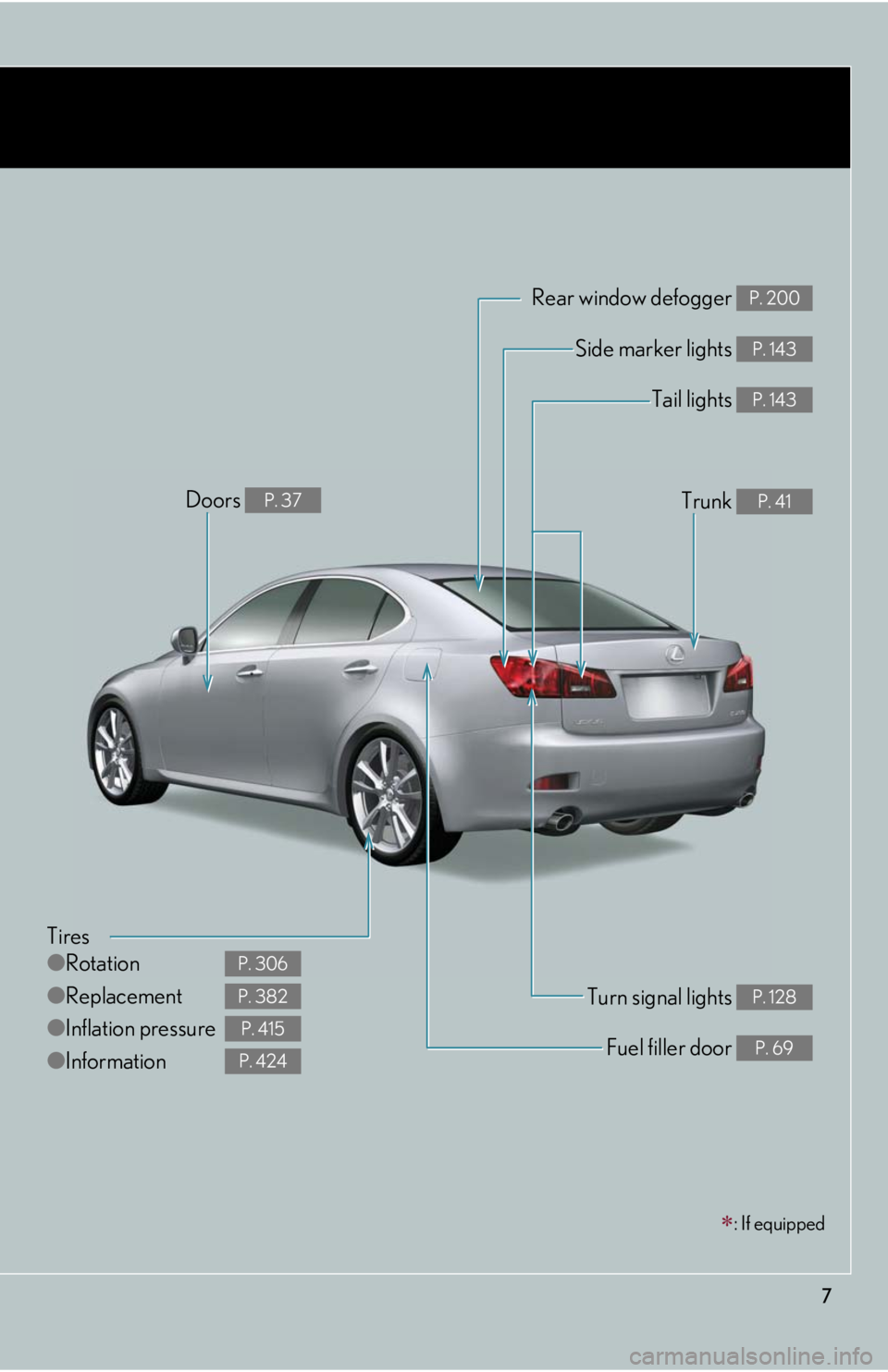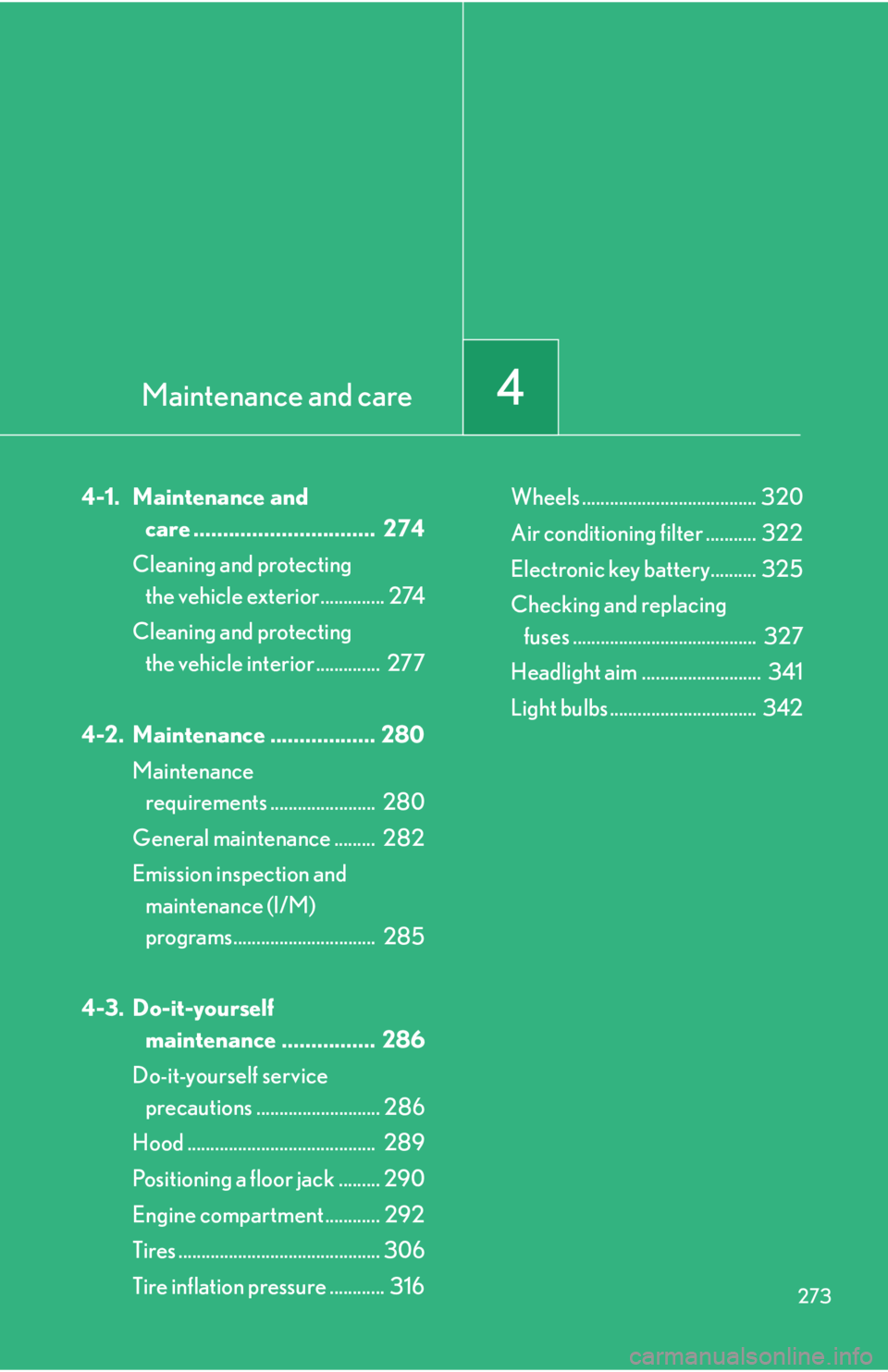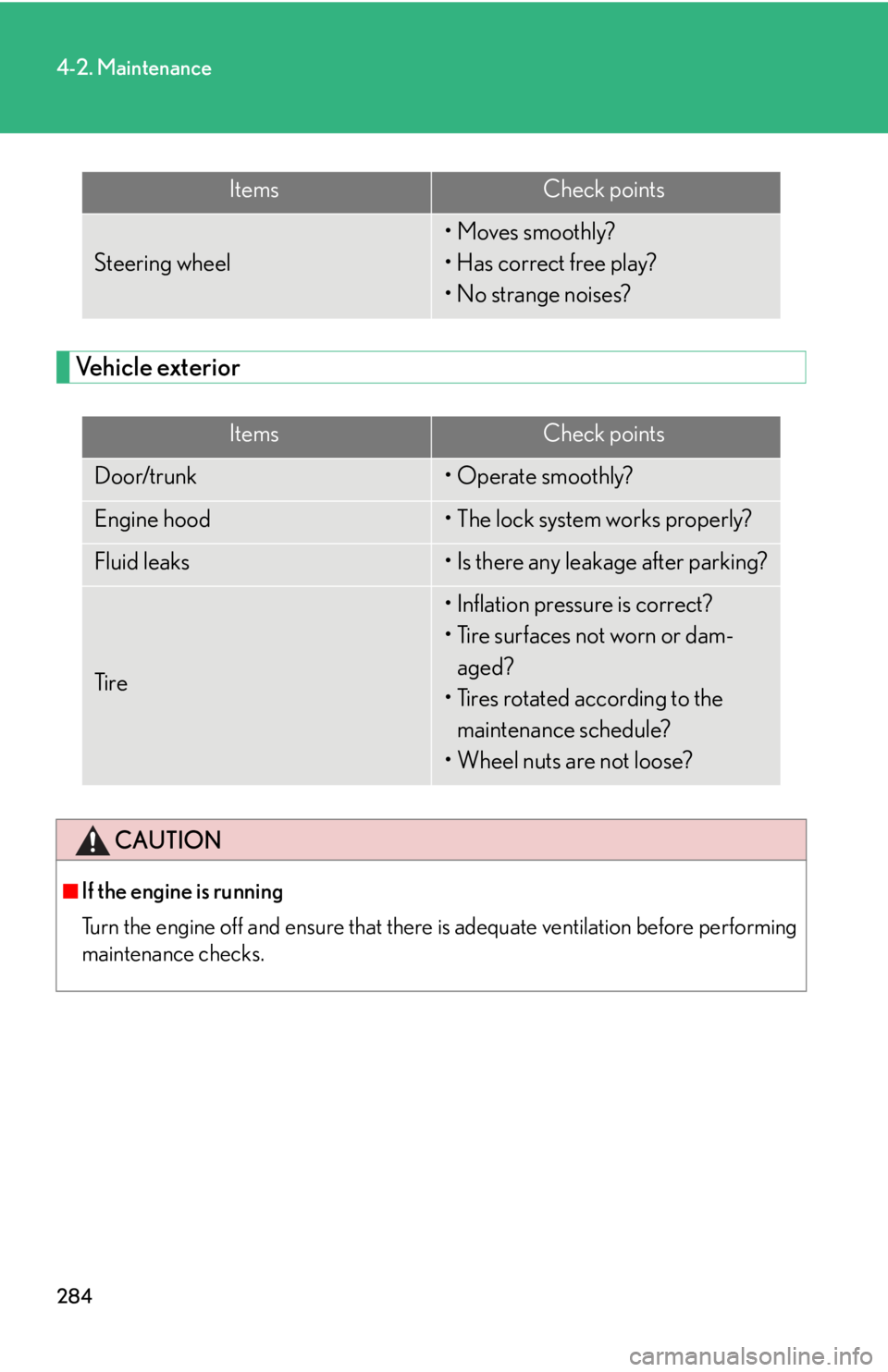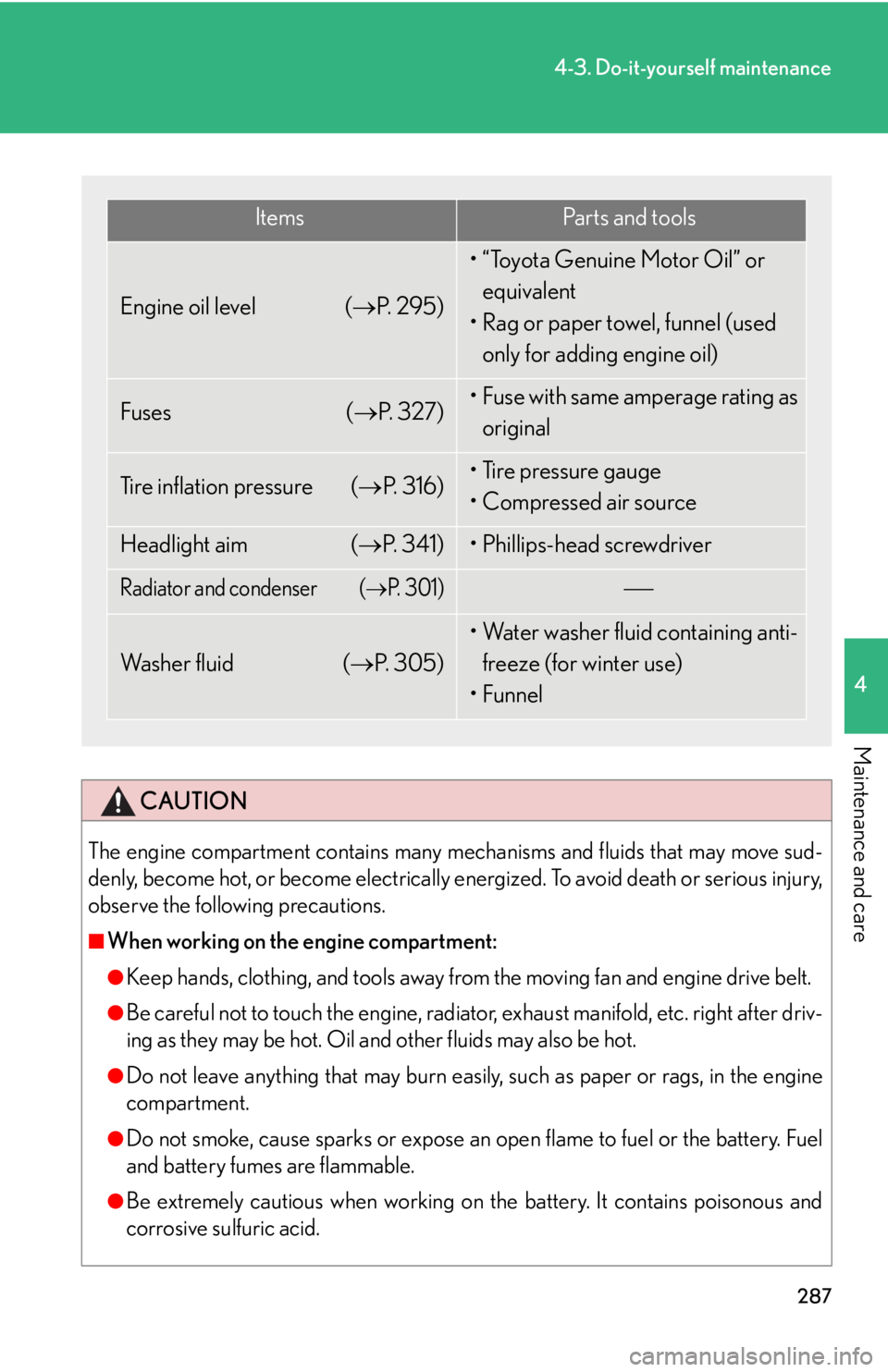inflation pressure Lexus IS250 2008 Using the air conditioning system and defogger / LEXUS 2008 IS250 OWNER'S MANUAL (OM53699U)
[x] Cancel search | Manufacturer: LEXUS, Model Year: 2008, Model line: IS250, Model: Lexus IS250 2008Pages: 464, PDF Size: 6.61 MB
Page 4 of 464

TABLE OF CONTENTSIndex
4
3-4. Using the storage features .... 236List of storage fe atures............... 236
• Glove box..................................... 236
• Console boxes ........................... 237
• Overhead console................... 238
• Cup holders................................. 239
• Bottle holders/ door pockets ................................ 241
3-5. Other interior features........... 242 Sun visors......................................... 242
Vanity mirror .................................. 243
Clock ................................................. 244
Satellite switches .......................... 245
Ashtrays .......................................... 248
Cigarette lighter ........................... 249
Power outlet .................................. 250
Seat heaters ..................................... 251
Seat heaters and ventilators .... 253
Armrest ............................................ 255
Rear sunshade ............................... 256
Trunk storage extension........... 258
Coat hooks ..................................... 259
Floor mat......................................... 260
Trunk features................................. 261
Garage door opener .................. 264
Compass.......................................... 269 4-1. Maintenance and care............ 274
Cleaning and protecting the vehicle exterior................... 274
Cleaning and protecting the vehicle interior .................... 277
4-2. Maintenance............................. 280 Maintenance requir ements .... 280
General maintena nce ................ 282
Emission inspection and maintenance (I/M)
programs ..................................... 285
4-3. Do-it-yourself maintenance............................ 286
Do-it-yourself service precautions .................................. 286
Hood................................................. 289
Positioning a floor jack.............. 290
Engine compartment.................. 292
Tires .................................................. 306
Tire inflation pressure.................. 316
Wheels............................................. 320
Air conditioning filter.................. 322
Electronic key battery ................ 325
Checking and replacing fuses ................................................ 327
Headlight aim.................................. 341
Light bulbs ....................................... 342
4Maintenance and care
Page 7 of 464

7
: If equipped
Tires
●Rotation
● Replacement
● Inflation pressure
● Information
P. 306
P. 382
P. 415
P. 424
Tail lights P. 143
Side marker lights P. 143
Trunk P. 41
Rear window defogger P. 200
Doors P. 37
Fuel filler door P. 69
Turn signal lights P. 128
Page 273 of 464

Maintenance and care4
273
4-1. Maintenance and care ............................... 274
Cleaning and protecting the vehicle exterior.............. 274
Cleaning and protecting the vehicle interior .............. 277
4-2. Maintenance .................. 280 Maintenance requirements ....................... 280
General maintenance ......... 282
Emission inspection and maintenance (I/M)
programs............................... 285
4-3. Do-it-yourself maintenance ................ 286
Do-it-yourself service precautions ........................... 286
Hood ......................................... 289
Positioning a floor jack ......... 290
Engine compartment............ 292
Tires ............................................ 306
Tire inflation pressure ............ 316 Wheels ...................................... 320
Air conditioning filter ........... 322
Electronic key battery.......... 325
Checking and replacing
fuses ........................................ 327
Headlight aim .......................... 341
Light bulbs ................................ 342
Page 284 of 464

284
4-2. Maintenance
Vehicle exterior
ItemsCheck points
Steering wheel
• Moves smoothly?
• Has correct free play?
• No strange noises?
ItemsCheck points
Door/trunk• Operate smoothly?
Engine hood• The lock system works properly?
Fluid leaks• Is there any leakage after parking?
Ti r e
• Inflation pressure is correct?
• Tire surfaces not worn or dam-aged?
• Tires rotated according to the maintenance schedule?
• Wheel nuts are not loose?
CAUTION
■If the engine is running
Turn the engine off and ensure that there is adequate ventilation before performing
maintenance checks.
Page 287 of 464

287
4-3. Do-it-yourself maintenance
4
Maintenance and care
CAUTION
The engine compartment contains many mechanisms and fluids that may move sud-
denly, become hot, or become electrically energized. To avoid death or serious injury,
observe the following precautions.
■When working on the engine compartment:
●Keep hands, clothing, and tools away from the moving fan and engine drive belt.
●Be careful not to touch the engine, radiator , exhaust manifold, etc. right after driv-
ing as they may be hot. Oil and other fluids may also be hot.
●Do not leave anything that may burn easi ly, such as paper or rags, in the engine
compartment.
●Do not smoke, cause sparks or expose an open flame to fuel or the battery. Fuel
and battery fumes are flammable.
●Be extremely cautious when working on the battery. It contains poisonous and
corrosive sulfuric acid.
ItemsPa r t s a n d t o o l s
Engine oil level ( P. 2 9 5 )
• “Toyota Genuine Motor Oil” or
equivalent
• Rag or paper towel, funnel (used only for adding engine oil)
Fuses ( P. 3 2 7 )• Fuse with same amperage rating as
original
Tire inflation pressure ( P. 3 1 6 )• Tire pressure gauge
• Compressed air source
Headlight aim ( P. 3 4 1 )• Phillips-head screwdriver
Radiator and condenser (P. 3 0 1 )
Wa s h e r f l u i d (P. 3 0 5 )
• Water washer fluid containing anti-
freeze (for winter use)
•Funnel
Page 308 of 464

308
4-3. Do-it-yourself maintenance
Installing tire pressure warning valves and transmittersWhen replacing tires or wheels, tire pressure warning valves and trans-
mitters must also be installed.
When new tire pressure warning va lves and transmitters are installed,
new tire pressure warning valve and transmitter ID codes must be regis-
tered in the tire pressure warning computer and tire pressure warning
system must be initialized. Have tire pressure warning valve and transmit-
ter ID codes registered by your Lexus dealer. ( P. 310)
Initializing the tire pressure warning system
■ The tire pressure warning system must be initialized in the following
circumstances:
●When rotating the tires on vehicles differing with front and rear tire
inflation pressures.
● When changing the ti re inflation pressure by changing traveling
speed.
● When changing the tire size.
When the tire pressure warning sy stem is initialized, the current tire
inflation pressure is set as the pressure benchmark.
Page 309 of 464

309
4-3. Do-it-yourself maintenance
4
Maintenance and care
■How to initialize the tire pressure warning system
To initialize the system, use the satellite switch. ( P. 245)
Park the vehicle in safe plac e and turn the “ENGINE START
STOP” switch OFF.
While the vehicle is moving, initialization is not performed.
Adjust the tire inflation pressure to the specified cold tire inflation
pressure level. ( P. 415)
Make sure to adjust the tire pressure to the specified cold tire inflation
pressure level. The tire pressure warning system will operate based on
this pressure level.
Turn the “ENGINE START STOP” switch to IGNITION ON
mode.
The tire inflation pressure initial-
ization setting display
Continue to press or until the
initialization setting display
appears.
It may take several minutes to com-
plete the setting. Wait for several
minutes before turning the
“ENGINE START STOP” switch to
OFF if necessary.
Recording tire inflation pressure
settings
Press and hold the “ON/OFF” but-
ton until the tire pressure warning
light blinks slowly 3 times and the
message “PRESSURE INITIAL”
showing that the initial setting is
complete is displayed on the multi-
information display.
Wait for a few minutes with the IGNITION ON mode, and then
turn the “ENGINE START STOP” switch OFF.
STEP1
STEP2
STEP3
STEP4
STEP5
Page 311 of 464

311
4-3. Do-it-yourself maintenance
4
Maintenance and care
■When to replace your vehicle’s tires
Tires should be replaced if:
●You have tire damage such as cuts, splits, cracks deep enough to expose the
fabric or bulges indicating internal damage
●A tire goes flat repeatedly or cannot be properly repaired due to the size or
location of a cut or other damage
If you are not sure, consult with your Lexus dealer.
■Replacing tires and wheels
If the ID code of the tire pressure warn ing valve and transmitter is not registered,
the tire pressure warning system will not work properly. After driving for about 20
minutes, the tire pressure warning light comes on after blinking for 1 minute to indi-
cate a system malfunction.
■Tire life
Any tire over 6 years old must be checked by a qualified technician even if they
have seldom or never been used or damage is not obvious.
■If the tread wears down below 0.16 in. (4 mm) on snow tires
The effectiveness of snow tires is lost.
■Low profile tires (models not equipped with 16-inch tires)
Generally, low profile tires will wear more rapidly and tire grip performance will be
reduced on snowy and/or icy roads when co mpared to standard tires. Be sure to
use snow tires or tire chains
* on snowy and/or icy roads and drive carefully at a
speed appropriate for road and weather conditions.
*: Tire chains cannot be mounted on 18-inch tires.
■Maximum load of tire
Check that the maximum load of the replaced tire is greater than 1 /2 of the Gross
Axle Weight Ratings (GAWR) of either the front axle or the rear axle, whichever is
greater.
As for the maximum load of the tire, see the load limit at maximum cold tire inflation
pressure mentioned on the sidewall of the tire, and as for the Gross Axle Weight
Ratings (GAWR), see the Certification Label. (
P. 3 1 6 , 4 2 4 ) .
Page 312 of 464

312
4-3. Do-it-yourself maintenance
■Tire types
1 Summer tiresSummer tires are high-speed performance tires best suited to highway driving
under dry conditions. Since summer tires do not have the same traction perfor-
mance as snow tires, summer tires are inadequate for driving on snow-covered
or icy roads. For driving on snow-covered roads or icy roads, the use of snow tires
is recommended. When installing snow tires, be sure to replace all four tires.
2 All season tires All season tires are designed to provide better traction in snow and to be ade-
quate for driving in most winter conditions , as well as for use year round. All sea-
son tires, however, do not have adequa te traction performance compared with
snow tires in heavy or loos e snow. Also, all season tires fall short in acceleration
and handling performance compared with summer tires in highway driving.
3Snow tires For driving on snow-covered roads or ic y roads, we recommend using snow tires.
If you need snow tires, select tires of the same size, construction and load capac-
ity as the originally installed tires. Since your vehicle has radial tires as original
equipment, make sure your snow tires also have radial construction. Do not install
studded tires without first checking loca l regulations for possible restriction.
Snow tires should be installed on all wheels. ( P. 1 8 3 )
■Initializing the tire pressure warning system
Initialize the tires with the tire inflatio n pressure adjusted to the specified level.
■When the initialization of the tire pressure warning system has failed
Initialization can be completed in a few minutes. However, in the following cases,
the settings have not been recorded and the system will not operate properly. If
repeated attempts to record tire inflation pressure settings are unsuccessful, have
the vehicle inspected by your Lexus dealer.
●When operating the tire pressure warnin g reset switch, the tire pressure warn-
ing light does not flash 3 times and the setting message does not appear on the
multi-information display.
●After carrying out the initialization proc edure, the tire pressure warning light
blinks for 1 minute then stays on after driving for about 20 minutes.
Page 313 of 464

313
4-3. Do-it-yourself maintenance
4
Maintenance and care
■Routine tire inflation pressure checks
The tire pressure warning system does not replace routine tire inflation pressure
checks. Make sure to check tire inflation pressure as part of your routine of daily
vehicle checks.
■Tire pressure warning system certificationFor vehicles sold in the U.S.A.
This device complies with Part 15 of the FCC Rules. Operation is subject to the fol-
lowing two conditions: (1) this device may not cause harmful interference, and (2)
this device must accept any interference received, including interference that may
cause undesired operation.
NOTICE:
This equipment has been tested and found to comply with the limits for a Class B
digital device, pursuant to Part 15 of the FCC Rules. These limits are designed to
provide reasonable protection against harmful interference in a residential installa-
tion. This equipment generate s, uses and can radiate radio frequency energy and, if
not installed and used in accordance with the instructions, may cause harmful inter-
ference to radio communications. However, there is no guarantee that interference
will not occur in a particular installation. If this equipment does cause harmful inter-
ference to radio or television reception, which can be determined by turning the
equipment off and on, the user is encouraged to try to correct the interference by
one or more of the following measures:
●Reorient or relocate the receiving antenna.
●Increase the separation between the equipment and receiver.
●Connect the equipment into an outlet on a circuit different from that to which
the receiver is connected.
●Consult the dealer or an experienced radio/TV technician for help.
FCC WARNING:
Changes or modifications not expressly approved by the party responsible for
compliance could void the user's authority to operate the equipment.
For vehicles sold in Canada
Operation is subject to the following two conditions: (1) this device may not cause
interference, and (2) this device must a ccept any interference, including interfer-
ence that may cause undesired operation of the device.